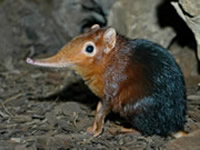Shrew

Peak Nuisance Period:Any time of Year.
Common Nuisance Situations:
- The pugnacious nature of shrews sometimes makes them a nuisance when they live in or near dwellings.
- Shrews occasionally fall into window wells, attack pets, attack birds or chipmunks at feeders, they feed on stored foods, contaminate stored foods with feces and urine, and bite humans when improperly handled.
- Potential exists for the transmission of diseases and parasites.
PLEASE NOTE THAT THE NORTHERN SHORT-TAILED SHREW IS VENOMOUS. ALTHOUGH NOT FATAL TO HUMANS, IT WILL CAUSE SEVERE PAIN. PLEASE CONTACT GOT WILDLIFE? LLC FOR PROPER, SAFE AND HUMANE REMOVAL.
There are 6 types of Shrews that call the Northeastern part of the United States home:
| Long-Tailed Shrew AKA Rock Shrew
Masked Shrew AKA Common Shrew Smokey Shrew |
Pygmy Shrew
Northern Short Tailed Shrew North American Least Shrew |
Animal Characteristics
| Shrew Type | Description | Diet | Habitat | Breeding |
| Masked | Grey brown in color-light grey underside-9cm long, 5 gr in weight – active all yr | Insects, worms, snails, salamanders and small mammals | Humid areas, damp northern forests | Mates in spring & fall – 3 to 6 young 1x/year |
| Smokey | Dull grey/lighter underpants/longtail brown on top, yellow underneath 11 cm long-5gr/active all yr round | Insects, worm, snails, small rodents | Found near streams in cool damp decidous mixed woods | Has 2 to 3 litters of 5 to 7 young |
| Pygmy | Grey brown or red brown w/lighter underparts-5 cm long & 2.5 gr in weight. Active all yr round | Insects, worms & small invertebrates | Northern coniferous & deciduous forests | Mates in early summer-1 litter of 5 to 8 young |
| Long Tailed AKA Rock Shrew | Slate grey with a pointed snout less than 9 cm long, active all year round | Insects, worms, snails, salamanders and small mammals | Humid areas, damp northern forests | Mates in spring & fall – 3 to 6 young 1x/year |
| Northern Short Tailed | Fur is thick,velvety, can be black, brownish black or silver grey-4.4 to 5.5 inches long- 15 to 30 gr. VENOMOUS. Active all yr round. | Earthworms, voles, snails, other shrews, salamanders, mice | Grasslands, old fields, marshy areas, forests, gardens | Mates March – September-2 litters of 4 to 7 young |
| Least | Long pointed snout and a long taildense coat that is grayish brown or reddish brown with a white belly-up to 3 inches long. Active all yr round | Small insects, corpses of dead animals | Grasslands & old fields | March to late November-2 litters of 3 to 6 young |
MythBusters: n/a
